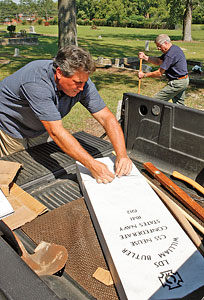Honoring William: Confederate sailor's memory not forgotten
By Kenneth Fine
Published in News on September 10, 2008 1:38 PM
It started with a simple phrase -- four of the only six words still legible on a 96-year-old tombstone.

News-Argus/Mitch Loeber
Kirk Keller, left, readies a new headstone for Confederate sailor William Butler as his father, Bob, digs out the original 1912 marker in Willowdale Cemetery.
"He served his country" -- common enough to be ignored by the average passer-by, but "everything" to the man who discovered it nestled under a tree inside Willowdale Cemetery.
The other two words sparked Charles Parks' interest.
"William Butler," they read.
So he started making phone calls, first to his friend, Bob Keller, then to the National Archives and N.C. Department of Cultural Resources.
He had no idea that months later, he and other members of the Goldsboro Rifles Sons of Confederate Veterans would help rewrite a lost page in Wayne County's Civil War tale.
It turns out Butler was a sailor, a landsman stationed aboard the CSS Neuse -- the 158-foot Confederate gunboat built at Seven Springs, burned by its crew in March 1865 after Union troops took Kinston.
Butler died 47 years later.
*
Keller backs a pickup truck down the strip of pavement that leads from his family plot to Butler's.
He parks in front of the grave and steps out.
He makes his way to the bed of the truck, stopping to reveal the new marble headstone he and Parks made possible.
"I'm kind of partial to this guy," Keller said. "I'm a Navy man myself."
It doesn't seem to matter that he and his son, Kirk, are breaking a sweat -- or that they have little shelter from the sun beating down, that it is 95 degrees.
The Keller boys have no intention of calling it a day.
Not until they pay homage to a nearly forgotten son of Wayne.
Bob grabs a shovel and starts digging.
"I'm going to lie this down behind it if I can," he says, pointing to the stone. "That's part of our deal with the Sons of the Confederacy -- repairing stones and such. Now, let's make this right."
Kirk slides the new stone into the hole his father made.
"It's heavy, isn't it?" Bob says with a grin, running his hand along the Maltese cross carved into the marble. "Yeah, that's real nice. I knew we could do something better than that old one."
*
Years earlier, the Keller boys were replacing another grave at Willowdale.
Bob found Confederate 1st Sgt. Mike Wood one day after visiting his uncle's grave.
"He was a shoemaker," Bob said. "When you're walking around this place looking, it's just like reading a book."
"We have got so much good history out here that needs to be told," Kirk added. "We need to honor everybody who was a part of the (Civil War)."
*
The hull of the twin-screw steamer Butler once called home now rests at a state park in Kinston.
The young sailor remains at Willowdale.
Keller admits it is fitting that both have been reborn.
A replica of the vessel is now open in Kinston, not far from the "cat hole" in the Neuse where the original sank.
And as for Butler, his name has been added to the list of 800-plus Confederates buried in Willowdale -- and through Parks and the Kellers, his legend -- and that of his ironclad -- will likely be told hundreds of times over.
Four simple words -- that is all it took.
"He served his country," the older Keller said, as a light breeze stirred the flags he and his son planted on either end of that marble stone last week. "That's real pretty to me. I hope (Butler) is looking down."
